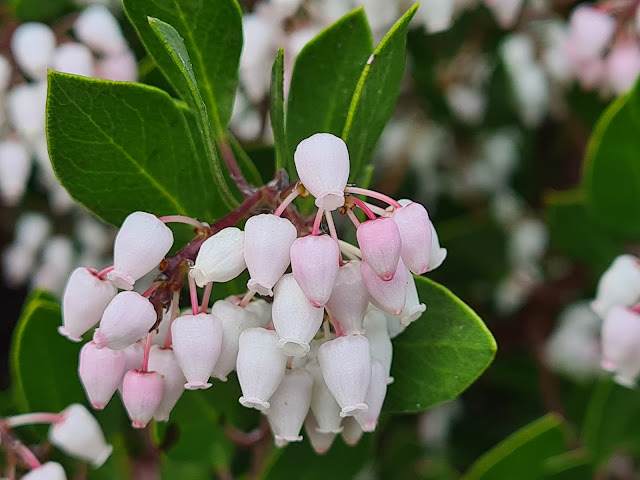Some little apple from California
This is a Manzanita, meaning 'little apple', or Bearberry, in our California Garden. That generic common name refers to the fruit that follows these heath-like flowers.
As the flower shape suggests, this genus is placed in the heath family, Ericaceae. The botanical genus name is Acrtostaphylos, meaning 'bear grape' because the fruits of some species are apparently eaten by bears. Those bears may well climb the crooked stems of larger species, which can be beautifully coloured with flakily barked - not unlike a Strawberry Tree (Arbutus) or perhaps Crepe Myrtle (Lagerstroemia). If you look through the leaves of this compact shrub you see the makings of that distinctive bark.
There are 66 or so species, from western North America through to Central America, with many native to California. There are also a couple of species adapted to subarctic and arctic regions across the Northern Hemisphere.
According to our living plant census, we grow six species from the Chaparral (Mediterranean-climate shrubland) region of North America in our Elisabeth Murdoch California Garden at Melbourne Gardens.
They are: Vine Hill Manzanita (Arctostaphylos densiflora), Hairy Manzanita (Arctostaphylos columbiana), Bigberry Manzanita (Acrtostaphylos glandulosa subspecies mollis), Hooker's Manzanita (Arctostaphylos hookeri), Mexican (or Point-leaf) Manzanita (Arctostaphylos pungens) and the one most commonly carrying the generic common name Bearberry (Arctostaphylos uva-ursi).
When that became a little complicated - and remember I blog for pleasure, not to occupy every waking moment - I used reliably identified online photographs and a process of elimination.
The leaves are not obviously hairy so I excluded Hairy Manzanita. The commonly called Bearberry, Arctostaphylos uva-ursi, is a very low rock or ground hugging shrub. Bigberry Manzanita has duller, grey-green leaves and hairy stems. So those three are out.
The leaves of Hooker's Manzanita are minutely hairy when young, but hairless when mature, and the leaf-base is rounded to wedge-shaped. The leaves in my photos are always 'acute' at the base and I can't see any hairs, even on new growth.
Penultimately, the Mexican Manzanita has pointed leaves, not unlike ours but it also has finely hairy young leaves. (Despite the name, this species does grows in California so it wouldn't be out of place the California Garden.)
I'm left then with Vine Hill Manzanita. I was worried at first about its stature, reading that it reaches only a metre tall in nature. Taking a closer look at our specimen I realised it is not as tall as it looks, and is wrapped around a hummock lined with volcanic rock. Not closely ground-hugging like the Bearberry, but not more than a metre tall either. This species is meant to be 'sparsely' hairy, which ours is, to an extreme.
So that's the name I'm sticking with. I notice our very own HortFlora avoids getting into the species detail of this genus, and that there are many hybrids and cultivars. I was comforted a week later by finding a smaller specimen elsewhere in the California Garden that looks very similar but with a aluminum tag! Pleasingly, that tag read 'Arctostaphylos densiflora', the Vine Hill Manzanita.
The Vine Hill Manzanita is a very rare species in nature, with perhaps less than 300 individuals alive today. This has earned it the status of 'critically imperiled'. Due to it being a 'showy shrub', the Vine Hill Manzanita is widely cultivated. Like the Wollemi Pine, its survival as a species seems assured while its persistence in 'nature' remains tenuous.





Comments